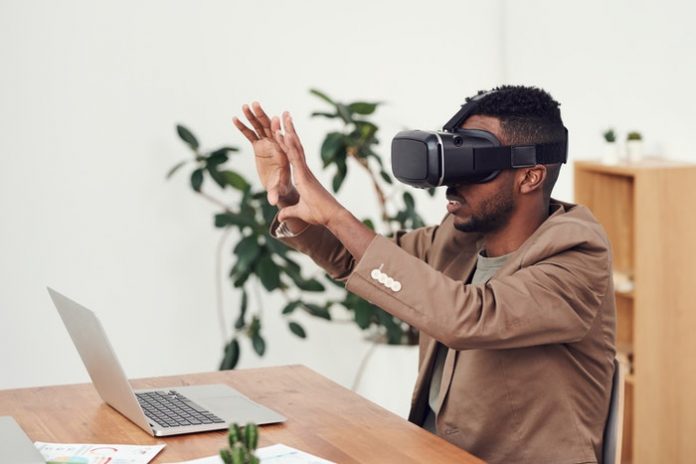Businesses and organizations of all sizes are in different phases of reopening offices and are constantly evaluating — and then reevaluating — what is safe, what is not and what the future will look like. While plexiglass dividers, floor decals and one-way walkways might not be permanent, one thing that is certain — the hybrid remote work environment is here to stay.
Whether working from home, safely from an office or a mix of both, teams are quickly realizing they must work in different ways and with different tools to communicate and collaborate effectively. As organizations face the next normal, technology has made working from home a seamless reality and advances in Augmented Reality (AR) are paving the way for richer work and collaboration experiences.
Remote Reality: AR Smart Glass Applications for Hybrid Remote Work
AR technology allows users to see digital work assets superimposed or positioned within the real world and can be delivered through a hand-held or hands-free device. Unlike hand-held devices such as mobile phones and tablets, coupling AR technology with a hands-free solution like AR smart glasses enhances the hybrid work from home (WFH) environment in several ways:
- An Additional Screen in Less Workspace: AR smart glasses provide an additional screen or heads-up display that is projected into the wearer’s line of sight, minimizing workspace by eliminating the need for a second physical monitor. Additionally, some smart glasses come equipped as a plug-and-play solution that utilizes USB-C connectivity with multiple devices, providing access to a wide range of third-party content and apps. Integrating AR smart glasses can help streamline daily tasks that require a “second screen” such as the comparison of multiple spreadsheets or the simultaneous use of multiple programs, as well as the need to monitor incoming emails or social media feeds in real time.
- Immersive Remote Collaboration and Training: AR smart glasses can create a multi-dimensional immersive experience by digitally transporting users into a virtual meeting room where information can be exchanged. AR provides visual details or 3D models for collaborative design and reviews, regardless of where each user is based. Whether designing creative components, planning out the elements of a design or reviewing plans with clients and partners, AR smart glasses provide a unique means for sharing and collaborating. AR smart glasses can also be used with conference and meeting platforms, like Zoom, for training and remote assistance. For example, in the healthcare industry, using AR smart glasses, on-site doctors can get advice from a remote expert to help provide a diagnosis and hospitals can connect inexperienced staff with remote experts to provide real-time visual guidance without the cost and logistics of getting everyone in the same room.
- Concept and Design Visualization: During an initial concept or design phase, AR enables users to bring products or a design to life by pulling the idea or object out of the screen and dropping it into the real world at full scale. Design teams can efficiently interpret the 3D digital prototype or mockup and how it relates to real-world environments. For example, architects, engineers and landscaping contractors using AR smart glasses to support conceptualizations and final appearances of their design ideas, can merge the computer-generated design directly onto the area and determine any last-minute changes before beginning construction, ultimately saving time and costs for future job site revisits and rework.
Benefits of Integrating AR Smart Glass into Hybrid WFH Environments
Incorporating AR smart glasses into the day-to-day hybrid remote work environment can provide the following benefits:
- Productivity: The heads-up and handsfree design of smart glasses allow for streamlined workflows. Depending on user needs, there are AR solutions available that enable switching between apps or “screens” based on the user’s head movement. Several AR solutions also offer features such as voice control, hand gestures and eye tracking for greater efficiency and control of workflow needs. AR smart glasses provide a more natural way for teams to review, edit and collaborate on work from a living room or home office, and sharing AR views enables multiple team members to edit 3D models from two perspectives simultaneously, resulting in an accelerated design development process.
- Digital Privacy and Security: Remote work presents a unique challenge for information security. In addition to your organization security protocols for safeguarding data, an important rule of thumb when working remote is to pay attention to your sight lines. When working with sensitive or non-public business information materials or legal documents, smart glasses provide a private view of content, enabling users to work without concern of outside views or access.
- Remote Flexibility: Whether traveling on a plane, via public transportation or in an autonomous car, users can continue to work during their commute using AR smart glasses. Additionally, remote users have the flexibility to seamlessly move from rooms in a house or another venue without the need to move around a physical monitor.
The Flexible Future of Hybrid WFH
Hybrid WFH is not going away anytime soon and recent projections from Global Workplace Analytics estimates over 25 percent of the workforce will be working from home a few days a week by the end of 2021. Circumstances have forced businesses to evolve at a faster rate, and companies have expedited incorporating collaboration tools into the day-to-day to improve communication over the long haul. And while there are new workday rhythms that need to be established and recognized at the individual level, AR smart glasses can enhance the hybrid WFH environment by creating a super-powered augmented workspace with multiple customizable screens, unrestrained from the limits of physical monitors.
Find a Home-Based Business to Start-Up >>> Hundreds of Business Listings.
















































